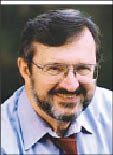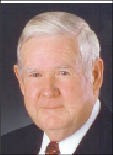For numismatists, 1943 is a year to remember – every penny minted that year was made of zinc. So, too, fiscal 2007 may be commemorated a century from now by good government types as an anomaly: an almost pork-free congressional budget that allowed Americans and their employers to actually compete for discretionary tax dollars.
The results of dozens of grant competitions throughout the executive branch will be known by late September. But the gift that lobbyist Jack Abramoff wrought is over. In fiscal 2008, a pork-famished Congress has returned to earmarking with a gusto worthy of a Coney Island hot dog-eating contest.
According to the authoritative Congressional Quarterly, the House appropriations bill for the departments of Labor, Heath and Human Services (HHS) and Education contains $282 million in earmarks for schools (including after-school programs), hospitals and social programs. The bill’s earmark total is 1,331.
Overall, the Democratic-controlled House has included almost 6,500 earmarks in all of its 2008 appropriations measures, totaling about $11 billion in spending, most of it opposed by the White House.
The frenzy for pork was similar in the Senate. There, for instance, the Labor-HHS-Education appropriation bill contains 1,038 earmarks totaling $562,880,710.
In 1996, the Republican-controlled Congress approved some 3,000 earmarks. By 2005, earmarks had grown to about 16,000. Then came the Abramoff-inspired cutbacks in 2006 followed by a year of total porkus interruptus.
“Certified” Reform
 |
|
David Obey |
After winning control of Congress, in part by campaigning against “a culture of corruption,” Democrats set about overhauling the system that Rep. David Obey (D-Wis.), chairman of the House Appropriations Committee, likened to “ATM machines” for members of Congress. In January, the Senate voted 96 to 2 for lobbying reform; the House passed its version in May on a 382 to 37 vote.
Basically, both versions are a sham. Opponent Sen. Tom Coburn (R-Okla.) told the Senate, “We’re lying to the American people when we say we’re fixing earmarks when we’re not.”
 |
|
John Murtha |
But members of Congress, especially Democrats, are hoping that voters are oblivious to the big picture while rejoicing in the success of their representatives in Congress. So what if Sen. Ted Stevens (R-Alaska) last year wanted to spend $200 million on a bridge to nowhere, while this year an Interstate highway bridge in Minneapolis collapsed into the Mississippi River, killing at least 13 people? Repeating an old canard, Rep. John Murtha (D-Pa.) said, “We don’t apologize for them [earmarks] because we think the members know as much about what goes in their district … as do bureaucrats.”
Murtha is dubbed King Corruption by House GOP members; his district, based in Johnson, Pa., is slated to receive 66 earmarks totaling $163,306,000 in seven of the 12 spending bills taken up so far by the House. None of Murtha’s earmarks was aimed at children’s services. The appropriation’s committee, which Murtha is on, did find $250,000 for road improvement in a cemetery in Springfield, Ill., at the urging of Rep. Ray LaHood (R-Ill.). Just how little has changed under Democratic leadership is demonstrated by the earmark chart on these pages. It is a partial list of nonprofit child- and youth-serving organizations that are scheduled to receive multiple earmarks in the fiscal 2008 appropriation bills.
In 2005, the last year with fully comparable data, these 22 groups received noncompetitive tax dollars from Congress totaling $161 million. The same 22 groups are in line for $142 million in fiscal 2008. The entire difference is due to a $20 million cut in the award to the Atlanta-based Boys & Girls Clubs of America.
Survival
Only one youth work-involved federal agency has successfully avoided having earmarks thrust on it by Congress: the Corporation for National and Community Service (CNCS), scheduled to get $768,905,000 in the House funding bill and $880,909,000 in the Senate appropriation. The Senate bill is a cut of $40,355,000 from last year’s $884,547,000.
However, the appropriations report from the House says that two “partnership” grantees of CNCS will “be eligible to compete” – polite talk for saying they’ll get earmarks. The report names them as America’s Promise Alliance (which got $4.95 million in earmarks in fiscal 2006) and the Points of Light Foundation ($9.9 million in earmarks that year).
Points of Light is in the throes of a merger with Atlanta-based Hands on Network, led by Michelle Nunn, whose Democratic pedigree – she’s the daughter of former Democratic Sen. Sam Nunn of Georgia – will be balanced by the network’s new board chairman: Neil Bush, the ne’er-do-well younger brother of President George W. Bush. The White House recommended both groups in its budget submission in February. No one expects CNCS’ board chairman, former Indianapolis Mayor Steve Goldsmith, or its CEO, David Eisner, to offer the least scrutiny of either award.
Not so lucky at avoiding the Capitol Hill privateers is the Administration for Children and Families (ACF) in HHS. Largely unscarred by earmarking in the past, ACF, where Daniel Schneider is acting chief since the departure of Wade Horn, is being stalked by a Congress eager to find new programs to poach on. Among those gaining earmarks are: TLC for Children and Families, Olathe, Kan. ($200,000), Lutheran Social Services, Duluth, Minn. ($350,000), and the Coalition for Homeless At-Risk Youth Services Program, New York ($350,000).
Can a small group of reformers, led by Colburn and Sen. John McCain (R-Ariz.) and Rep. Jeff Flake (R-Ariz), stop Congress before it kills again? The ACF earmarks will likely come out of the competitive funds available for runaway and homeless youth programs. Will Congress slaughter the Family and Youth Services Bureau, which administers the Runaway and Homeless Youth Act, as it has done with discretionary spending under the Juvenile Justice Act?
The Dirt on Pay
Recruiting and retaining competent youth workers is – money excepted – the most pressing issue looming over the youth service field. Two national groups have taken on this thankless and gargantuan task.
One group, the Initiative for Nonprofit Sector Careers, housed at Kansas City-based American Humanics, is staffed by Stephen Bauer. The other, the Next Generation Youth Work Coalition, focuses just on youth work. It is a joint endeavor of the National Human Services Assembly and its Collaboration for Youth, along with the also D.C.-based Forum for Youth Investment. Irv Katz runs the assembly and Karen Pittman the forum, where Pam Garza plays a central staffing role.
Footing the bill for most of this work is the Baltimore-based Annie E. Casey Foundation and a mostly Casey-funded offshoot called Cornerstones for Kids, directed by Sharon Edwards and Ira Cutler. Getting media or public attention focused on children and youth service work force issues is no easy matter. (Full disclosure: Cornerstones has given Youth Today a $25,000 grant to cover those issues.)
However, disparate events have thrown into sharp contrast the growing wage disparities in the nation’s work force. In late July, a Washington Post article, “No Objections Here,” gave the views of summer interns at Washington’s tony law firms, whose legal practices are centered on the principle that “my rich guys deserve more profit than your rich guys.” One law school student, Amy Jenkins, 24, is being paid, like her peers, the equivalent of $140,000 per year during the summer.
A former youth worker/camp counselor in North Carolina, Jenkins told the Post, “I definitely feel like a grown-up for the first time, because it’s the first real responsible type of job I’ve had, as opposed to taking girls out to the river” at summer camp.
Less than two weeks after that slam on the value of youth work, Jeremy Hernandez was returning from an aquatic outing in Minneapolis. The 20-year-old Hernandez earns $10 an hour as a youth worker for Waite House, a program of Pillsbury United Communities, a $14 million per year agency led by CEO Anthony R. Wagner. Hernandez, seven other staffers and the driver of a yellow school bus were on board with 52 kids when the Interstate 35W bridge over the Mississippi River collapsed, leaving the bus hanging high over a guard rail.
Despite not having what lawyer-to-be Jenkins described as a “real responsible type of job,” Hernandez rose to the emergency and skillfully helped save everyone on the bus from a fatal swim in the mighty Mississippi.
Last Christmas, Hernandez had dropped out of a community college because he couldn’t afford it.
It is unlikely that more than a handful of the nation’s 141,031 law students mull over human service work force matters. Few students at Massachusetts’ seven law schools would notice an April report, “Recruiting and Retaining the Next Generation of Human Service Workers in Massachusetts,” by the state’s Council of Human Service Providers. The report estimates the state’s human service work force at more than 100,000. In late 2004, statewide job vacancies in that sector totaled 15,744. Since then, the situation has grown worse, says Bill Lyttle, president of the Key Program, a statewide youth-serving agency with 470 staff members.
Lyttle, a member of the Council’s Workforce Committee, laments the low wages of youth workers; he regularly loses competent and trained staff to higher paying jobs. Considering that student debt in Massachusetts averages $14,000 per college graduate, and that full-time wages of $20,000 are common among direct service workers, it’s a wonder there are any young adult staffers at all.
Maybe they should all just quit and go to law school. After all, there are only 1,143,358 lawyers in active practice in the United States. Some day soon, intern Jenkins will be one of them.
Meanwhile, Hernandez won a scholarship to return to community college.
Contact: National Human Services Assembly (202) 347-2080, http://www.nassembly.org; Forum for Youth Investment (202) 207-3333, http://www.forum.org.fyi; Cornerstones for Kids (713) 627-2322, http://www.cornerstones4kids.org.

























